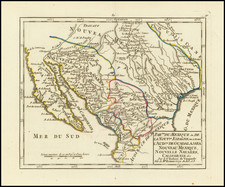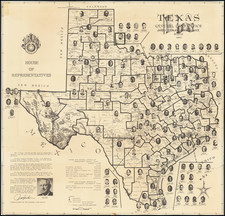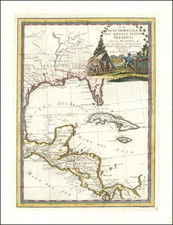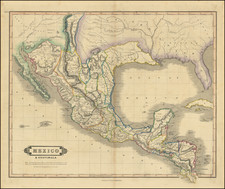Charting the Waters of the Yucatan Peninsula in the Late Colonial Period
Sharply-rendered Spanish manuscript chart of the waters near the Yucatan Peninsula from 1799.
The chart was drawn by an officer or a naval engineer, Joaquin de Aguirre, in August 1799 on a voyage that tested chronometers made by John Arnold of London. Aguirre was part of the squadron commanded by Don Jose Solano y Bote, one of the highest-ranking officers in the Spanish Navy.
The chart shows the precisely-delineated western Gulf of Mexico, including parts of the coasts of what today are Honduras, Belize, Mexico, Texas, and Louisiana.
Intended to orient navigators, the chart includes sounding depths, rocks, shoals, sandbars, small islands, and other obstructions. Rhumb lines radiate in a dense grid, ready to aid in plotting a course.
Don José Solano y Bote
Aguirre was part of the squadron of the renowned Don José Solano y Bote, Marqués del Real Socorro (1726-1806). Solano was one of the most important Spanish naval figures of the eighteenth century. He entered the Spanish Navy at age sixteen and quickly distinguished himself at the Battle of Toulon (1744).
Thanks to his excellent head for mathematics, shipbuilding, and engineering, he was selected to accompany Jorge Juan, the naval engineer who was part of the transnational expedition to measure the arc of the meridian at the equator, on an espionage trip to England. Ostensibly, Juan was there to meet with the scientific community—he was named a Fellow of the Royal Society while in London—while Solano was supposedly improving his math skills. In reality, they were gathering intelligence on the Royal Navy’s capacity and technology.
Solano then accompanied the Irish minerologist William Bowles on an expedition across the Iberian Peninsula. This experience recommended him for the boundary commission that was supposed to delimit Spanish and Portuguese holdings in the Americas, part of the Treaty of Madrid of 1750. For seven years (1754-1761), Solano explored the Orinoco and its environs.
After 1761, Solano returned to life on deck as a Capitán de Navio, but this was interrupted when he was named Governor of Venezuela in 1763. His administration (1763-1770) is considered to have been a measured one of reform and innovation. Next, he was the Capitán General of Santo Domingo (1771-1779), where he re-negotiated the border with the French.
War drew him back into command at sea. Solano led a Caribbean squadron during the Anglo-Spanish War (1779-1783). As part of the Siege of Pensacola, he came to the aid of the Governor of Louisiana, Bernardo de Gálvez, which is one of his best-known actions. His leadership and successes in battle earned him the title of Marqués del Real Socorro in 1784.
Solano served as a government official in the late 1780s and early 1790s. In 1794, he was appointed to lead the American squadrons of the Spanish Navy. It was in this capacity that this chart was made with the input of his pilots. Solano was known for prioritizing hydrography and scientific endeavors, so it is no surprise that his ships would be testing new technology like Arnold’s chronometers.
In 1802, Solano achieved the highest position possible for a naval officer, Capitán General de la Armada. He died in Madrid in 1806.
Spain and the eighteenth-century search for longitude
Control of scientific inquiry and innovation in Spain was largely institutionalized during the eighteenth century. This made the Spanish Navy, and its Observatory at Cadiz, the central node of inquiry and experimentation with regard to answers to the longitude problem. The two main methods for finding longitude at sea—marine chronometers and lunar distances—required acquisition of the said chronometers or mathematical training to calculate lunars.
Lunars, which from 1772 were aided by the publication of the Nautical Almanac, were adopted quickly. Juan de Lángara and José de Mazarredo on the Venus and bound for Manila were already making the necessary calculations when they acquired the almanacs for 1772 and 1773 from a passing British ship. Their success spurred the Academia at Cadiz to quickly organize a two-month course on lunars.
Following the cessation of the Anglo-Spanish War in 1783, the Spanish Navy sought to bolster the navigational and scientific training for its officers with a new Higher Studies Course which added to the already rigorous math curriculum. The Navy tended to require officers to perform the complex calculus themselves, rather than depending on the tables of the foreign Nautical Almanac or its French counterpart. From 1792, however, the Cadiz Observatory began to publish their own tables.
As for marine chronometers, Jorge Juan saw John Harrison’s sea clocks in London when he was there spying at mid-century, but buying one proved too difficult. In the late 1760s, several French expeditions, which were testing the chronometers made by Pierre le Roy and Ferdinand Berthoud, called at Cadiz. This gave opportunity to the Spanish Navy to learn more about the time-keepers and to handle them.
The Spanish government purchased Berthoud’s chronometers, numbers 7, 9, 10, and 12, in 1774, followed by numbers 13, 14, 15, and 16 in 1776. They also acquired John Arnold’s chronometers 3, 5, and 6—it is likely a later Arnold chronometer that is mentioned on this chart.
Both methods were called into use as the Spanish Navy began a new charting initiative in 1783. Many students who took the Higher Studies Course led the surveying expeditions of Spain’s American holdings in the final two decades of the eighteenth century. To improve charts of the Spanish coasts, an expedition which lasted from 1783 to 1787, naval engineers used Berthoud’s chronometers 10 and 13. These, and at least one Arnold clock, were also the chronometers which Malaspina took on his circumnavigation (1789-1794), which produced hundreds of new, detailed charts. Cosme de Churraca oversaw a hydrographic project focused on the Gulf of Mexico and the Caribbean, the Atlas de la América septentrional, from 1792 to 1805. However, this chart does not seem to come from that enterprise.
These initial purchases were not well maintained, unfortunately, and by the late 1780s several chronometers were sent back to Berthoud for cleaning and repair. Berthoud offered to train someone in their maintenance and the Spanish government selected Cayetano Sánchez to travel to Paris and then London to learn. Sánchez received a contract with the navy in 1793 that obliged him to repair all the naval chronometers, as well as those which had been purchased individually by officers, but which also allowed him to maintain a private practice. Unfortunately, a yellow fever outbreak killed Sánchez and his assistants in 1800. Mazarredo, now a high-ranking naval official, said of Sánchez, he “"may have been far from being an Arnold in terms of invention and advances. But in the state of the art of clockmaking up until now, in carrying out what Arnold had already instigated, he was this man's equal" (as quoted in Lafuente).
Two more apprentices were sent to Paris to learn the craft of chronometers, but the naval clock workshop never flourished.
Provenance
Sothebys lot 164, sold on June 21, 1990; Group lot, including two manuscript charts and four printed charts.














![(Panoramic photograph) Camp Travis, Tex. 9/8/1918 East Side [WWI Camp Travis, near San Antonio, Texas, African American Troops]](https://storage.googleapis.com/raremaps/img/small/87312.jpg)